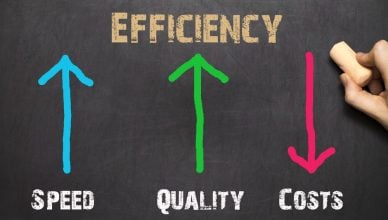Planning efficient routes, especially when you have multiple drivers serving multiple customer locations, is more difficult than you could imagine. Inefficient routes can land your drivers in traffic congestion, resulting in loss of revenue and customer satisfaction. In fact, according to one report, being stuck in traffic costs each driver in the United States more than 97 hours and $1,348 each year.
Multi-stop routing can become even more daunting if your business relies on pen and paper to plan routes. Such manual route planning is not only time-consuming and inefficient, but it also puts your business at risk of failing to meet customer expectations. For instance, if each one of your 15 drivers had to deliver 70 packages, how would you go about planning the best multi-stop route? Solving the problem of multi-stop routing is an attractive proposition for field service businesses because it means less time on the road, fewer drivers, reduced fuel costs, and increased customer satisfaction.
Also, anyone who has used Google Maps or a route optimization software will know that there is always more than one right way to create a route. The delivery management system you are currently using can give you hundreds and thousands of possible combinations for building routes around your customer addresses.
This is because, for any field service manager, multi-stop routing is a highly customized process that must take into account road conditions, traffic congestion at different times of the day, and the marginal benefits of making a left or right turn at a junction. In addition, according to a recent survey, nearly 37% of US customers changed delivery preferences on the fly after placing orders. Yet, customers expect flexibility and so businesses must be agile.
Ultimately, efficient multi-stop route planning helps businesses better meet customer demands. But, how can you do efficiently plan routes? Let us find out.
How to Succeed at Multi-Stop Routing?
Planning multi-stop delivery routes is a minefield, but, with a little foresight, you can optimize even the most challenging routes. Below are some tips to help you become a pro at multi-stop routing.
Plan Well-Optimized Routes
Just imagine the time and fuel your drivers would waste on unfamiliar roads and bad traffic if you send them on their routes without giving them well-optimized routes or directions. Such situations may lead to stressed drivers who will be more prone to mishaps on the road.
Moreover, if you are looking to stay within budget, you are at a disadvantage when it comes to fuel and other transportation costs as these add up fast. And, with fuel being as expensive as it is, having multiple destinations may not appease your budget.
So, go for a multi-stop route planner that will help you save time and fuel by planning efficient routes while factoring in traffic congestion, roadblocks, and other aspects of being on the road. This will help increase your drivers’ safety and productivity.
Track Your Field Employees
It is one thing to be able to give your field employees specific instructions about where they need to go, but a whole other to ensure they are following those instructions. You are paying for their fuel and time and so you cannot let that slide. This is why it is critical to find a way to keep an eye on your drivers and stop them from wasting their time and your money. A route planner like Route4Me can do that by tracking their movements in real-time.
Divide Large Service Area into Different Territories
Windshield time, namely the unproductive time that drivers spend behind the wheel to travel from one location to another, is one of the many hidden expenses of field service businesses that nibbles away at profitability. And, if your business operates in a large service area, with heavy traffic or construction, your windshield time can add up to hours. So, making your drivers go back and forth across your service area is a waste of fuel and time.
Want To See For Yourself How Route4Me Can Boost Your Profits?

Luckily, you can improve your drivers’ productivity by dividing the service area into different territories and assigning each territory to a driver. This will help reduce travel time, which means increased productivity and less fuel consumption. That is a win-win situation for everybody.
Prioritize Urgent Deliveries
Assigning territories to different drivers is one thing, but what if a customer demands immediate delivery? To solve this problem, it is crucial to consider priority deliveries and flag jobs that cannot wait another day. And, if you place such urgent customer locations at the top of the list and use them as the point of origin for your route, you can optimize your routes to save fuel as well as deal with urgent requests.
Add Notes and Do Color Coding
Not all routes and customers are easy. Fortunately, you can guide and encourage your drivers or sales reps to treat every route or customer as an opportunity to learn something new and take notes along the way. To begin with, you can save these notes in a spreadsheet and color code them. You can also analyze the notes and see which routes were the quickest or the most troublesome. In addition, you can save your color-coded notes at some centralized location where all of your field employees can access them.
Conclusion
Efficiency begins and ends with ensuring your drivers complete their jobs in an efficient and timely manner. These tips will help you effectively plan your routes.
Remember, positive customer experience is crucial for running a fruitful business and timely deliveries and efficiency is key to improving your business’s customer experience. In fact, according to one report, nearly 89% of customers have stopped doing business with a company after experiencing poor customer service. Also, faster response times and timely deliveries not only increase your drivers’ productivity, but they also create pleasant customer experiences.
The best part is that you do not need to do all the hard work when there are advanced tools like delivery management software available to help you plan more deliveries while saving time, effort, and fuel.
So how do you plan routes? Do you’ve any questions? Please feel free to leave your comments below.
Want To See For Yourself How Route4Me Can Boost Your Profits?







